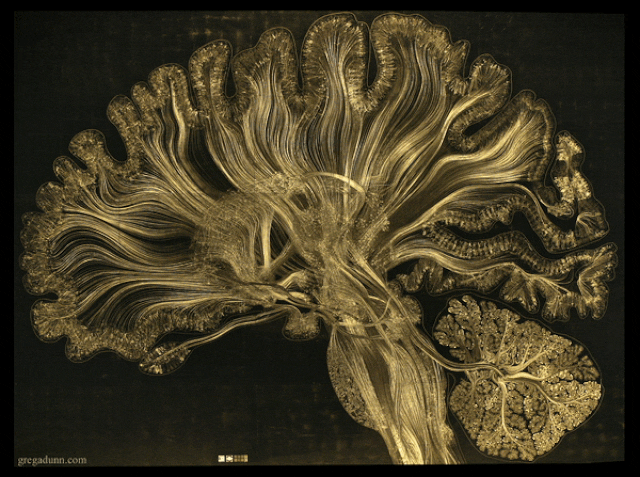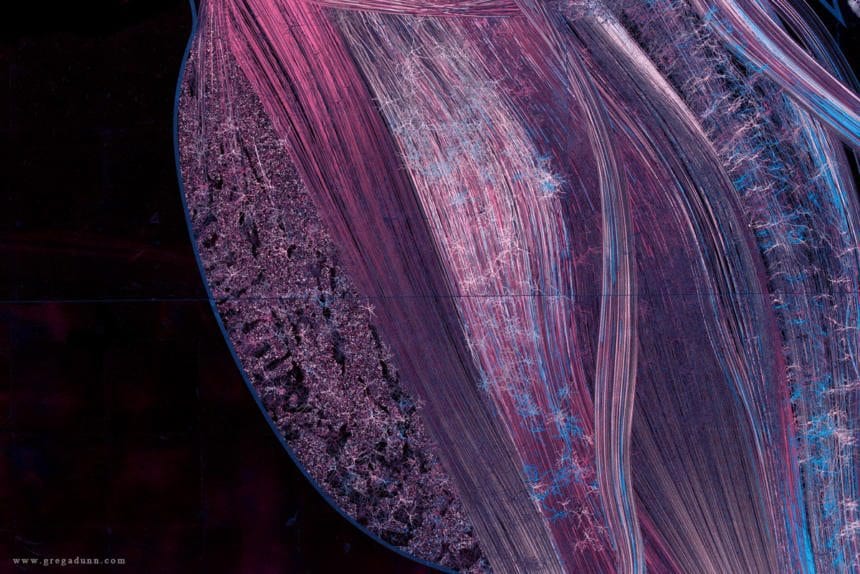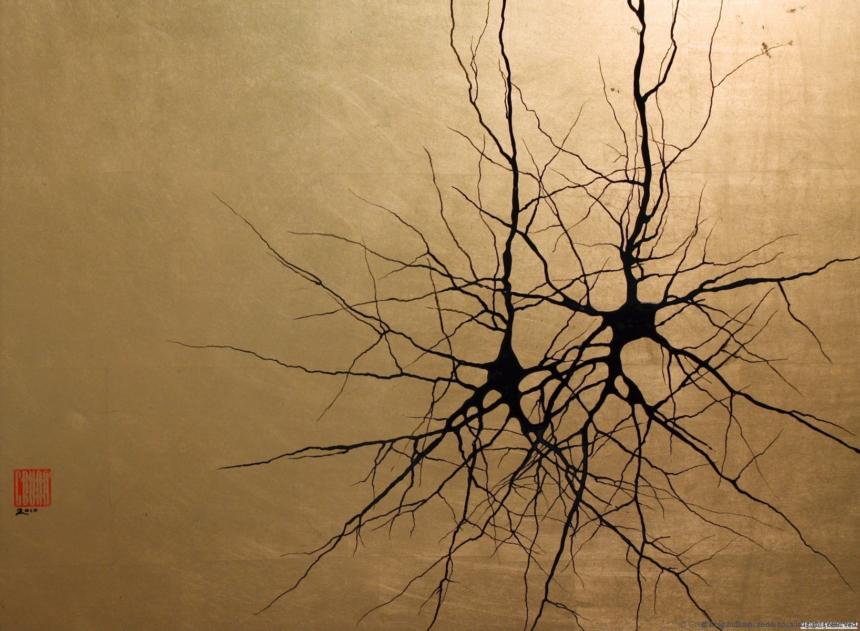Elucidating Human Consciousness Through Art
After receiving his doctorate in neuroscience in 2011, artist Greg Dunn made an unconventional decision: to dedicate himself to his art. A long time observer of human consciousness, his images of the human brain have been displayed in museums all over the United States, including the Franklin Institute. He recently spoke with the Garrison Institute about his art, philosophy of the mind, and why he compares his work to that of Zen artists.
How did you get started as a professional artist?
My original plan was to go the academic route. Then I started painting the first year into my neuroscience degree. At some point, I realized that I just wasn’t producing anything in the laboratory that others couldn’t have produced—I was a decent scientist, but not a genius. I felt that the combination of my interests that was manifesting in the art was making more of a contribution. I really became an artist in my last year of grad school. It was as surprising to me as anybody else.
In both your scientific focus and your artistic work, you’ve focused on the human brain. Why?
I’ve always had a hard time choosing what I’m going to spend my time doing. The brain is the ultimate common denominator for everything that you could possibly do or think. Everyone has one. It doesn’t get any more expansive than that.
There are so many ways to look at the brain—from its raw, anatomical, functional standpoint to the metaphorical product. I’m also interested in the balance of what is hardwired and what is learned. You could spend a lifetime exploring it. And, from a practical standpoint, there’s not a lot of people who paint the brain. And if they are, they typically don’t have a PhD in neuroscience.
So in a sense, the brain is both a blank canvas and every single canvas ever created. What are the differences between approaching the brain through art and science?
It’s hard to differentiate. I think the most I’ve ever learned about the brain was working on Self Reflected, which was a two-year project of this gigantic, animated microetching. When I was trying to wrap my head around how to communicate ideas about the brain, I decided to really emphasize that the brain is bordering on this knife’s-edge balance between order and chaos. It became apparent that when the brain is differentiating there are literally tens of billions of things happening.
The degree of sophistication that the brain has could not tolerate that amount of randomness if it didn’t have a compensatory mechanism. That aspect became very clear when I was trying to orchestrate half a million neurons and how they connect. It became apparent that this was a substantial problem that evolution had to solve at some point. Science and art became inseparable.
 Self Reflected by Greg Dunn | 2012
Self Reflected by Greg Dunn | 2012
Can you explain your process for creating the images used in Self Reflected?
The basic idea behind reflective microetching is a giant, reflective template which has the potential, through etching angles in the surface of gold, to depict movement. It’s a cousin to the holograph. We’re able to encode animations through really precise mathematics of where the light is and where the angles are etched in relation to it.
First, we researched all the regions of the brain to figure out what the neurons looked like, what they’re connected to, and the firing patterns. That information was compiled into huge spreadsheets, which were used as references to paint all neurons of the brain. We painted maybe five examples of nerves in the brain, so maybe 150 different neurons, then scanned them into the computer and turned them into math. They became vector objects, which is a mathematical description of an outline, which allows you to then work with that object much more flexibly than you would be able to in an image made of pixels.
We painted all the neurons using this method, and put probably a million of them down. And then we drew the white matter, which are all the connections between the neurons. Those are the axons which travel along the brain in inches. Using diffusion spectrum imaging with an MRI scanner, we recorded a diffusion of water molecules in voxels, which is a three-dimensional pixel in the brain. This scan produced a three-dimensional map of where all these billions of axons go and what they look like.
We used that data as a guide to draw the axons, and then fed our axon data and our neuron data into an algorithm. It started to form this group of neurons, connect to axons, and then it sent out some of these neurons, connect with this group of axons, and so on to build these chains of activity which create the shape of the brain. The algorithm helped us to make those connections, finalize the timing of the connections, and, in some cases, to help draw what the axons look like. It basically simulated what the activity of half a million neurons looks like at once.
It took months and months to figure out a lot of this stuff. At the end, after about ten days just of dedicated computer processing, it spat out the images of the timing data. They’re rainbow-hued images, where the color encodes the animation. The red pixels would be viewable at the beginning of the animation, and then you would see the orange ones, then yellow, green, blue, and, finally, violet.
I think one thing that’s really important to say is that it is not a scan. We didn’t just take pictures through a microscope. We made this piece to be able to see the neural activity on the scale of single neurons, and to see it in the context of the whole brain. That’s the reason that we put so much effort into Self Reflected, because we wanted to change the way that people think about the brain. We had to invent all these techniques in order to communicate what we wanted to.
 Self Reflected by Greg Dunn | 2012
Self Reflected by Greg Dunn | 2012
What is it about the microscopic view that you find so inspiring?
It’s just incredible how much arises from it. The neurons themselves are immensely beautiful. Their shapes are a testament to how chaos rules our environment. You see the shapes of neurons in tree branches, lightning bolts, and cracks in the pavement. It’s often times the shape that you get when you have some force that’s causing a line to be elongated. It’s energy finding the path of least resistance.
That’s wonderful, the ability to see the neurons displayed over and over in nature.
It’s incredible. You see neural shapes in galactic super clusters; thousands of galaxies oriented within the universe. You’re just kind of scratching your head, asking what does this have to do with us? With me? It’s a very bizarre idea. You see it independent of scale. It’s more evidence that the universe gets arranged into these kinds of repeating patterns.
You’ve said that there is a Zen quality to the neurons that you capture. What do you mean by that?
It’s a lot like ancient art forms. Many Sumi-e ink painters were monks who practiced for many years to be able to paint with only a few simple strokes. One thing that’s characteristic about that art form is the use of negative space, and random branching patterns. The brain sucks at making random things. It takes practice to unlock your mind from the desire to make patterns. Learning how to paint like that is a method in freeing your mind. It’s one of the reason that the masters of Sumi-e painting spend their whole lives learning how to erase their context, to let that spontaneity come forth. That’s what I see as Zen; creating without thinking.
Do you have a contemplative practice of your own?
In my early 20s, I was very seriously considering becoming a monk. I kept up a practice over the years, and I have a sensory deprivation tank in my house. It’s an important part of my life and who I am.
One thing I really want to do is to divorce myself as much as possible from dogma. I talk about the same ideas, but I don’t want people to react to the fact that it’s working from a traditional form. Remaining secular avoids that knee-jerk reaction.
When you’re creating these pieces, what sort of mindset are you in?
I always paint better when I’ve meditate beforehand—every single time. I forget that sometimes, but that always, always helps. Quite frankly, it just makes me better at everything. Just in terms of physically stilling your body and clearing out your mind before you start to paint.
 Two Pyramidals by Greg Dunn | May 17, 2012
Two Pyramidals by Greg Dunn | May 17, 2012
What do you hope to achieve with your art?
A lot of it is to help people raise their awareness of what the brain is, and to break out of the ways that people are used to showing the brain. Looking at how illustrators typically depict the brain is so rote. Everybody iterates off basic scientific illustrations. I just want to yell, “Stop it!”
The brain is the most complex, astonishing object in the known universe and every single person has one in their head. You can get so wrapped up in the details of anything, that you forget to stop and just remember the fact that our consciousness and our existence is the result of this miracle—and we never think about it.
This article is republished here with permission from the Garrison Institute where it first appeared. The Garrison Institute applies the transformative power of contemplation to today's pressing social and environmental concerns, helping build a more compassionate, resilient future. Linda Codega is the Garrison Institute’s Marketing and Communications Manager.
SHARE YOUR REFLECTION
3 Past Reflections


On May 7, 2018 Patrick Watters wrote:
Beautiful. ❤️
My son and daughter-in-law share a deep appreciation likewise though in practice as professor and medical doctor; he a PhD in astrophysics (cosmology), and she a neuroscientist and OB/Gyn MD.

On May 7, 2018 WALTER LUIS BASTOS DOEGE wrote:
astonishing work about the brain and human being, consciousness and neuroscience, art and science. Wonderful article.

On May 9, 2018 Corinne Schnur wrote:
Wow. Gorgeous.
1 reply: Elaine | Post Your Reply